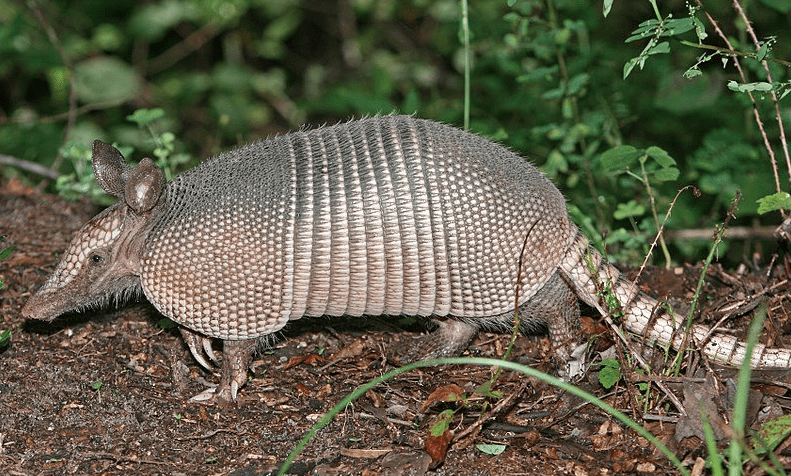Howard Fischer
Uppsala, Sweden
 |
| A nine-banded armadillo in the Green Swamp, central Florida. Photo by Tomfriedel (BirdPhotos.com), June 27, 2008, on Wikimedia. CC BY 3.0. |
Leprosy (Hansen’s disease) is a chronic, disfiguring, and handicapping infectious disease. It was known in the ancient world, and evidence of the disease has been found from 2000 B.C.1 In the sixth and seventh centuries it spread in Europe, peaking in incidence in the thirteenth and fourteenth centuries.2 The disease may have originated in East Africa or the Middle East, and was spread by the Crusades, commerce, and the slave trade.3
The nine-banded armadillo (Dasypus novemcinctus), a New World mammal, may become infected by M. leprae. There is no evidence that M. leprae existed in the Americas before the arrival of Europeans, who managed to expose armadillos to the bacterium, probably via the soil.
The armadillo (Spanish for “little armored one”), of which there are twenty-one species, is on average seventy-five centimeters long. It is covered with bony plates that are covered by a layer of keratin.4 It has a body temperature of 32–35°C, which is favorable for the growth of M. leprae.5 Armadillos are found in South and Central America, Mexico, the southern U.S., and as far north as Illinois and Nebraska.6 There are millions of armadillos in the U.S. South.
 |
| Two men with leprosy, M.P., India, 1960. Mennonite Board of Missions Photographs, 1898–1967. IV-10-007.2 Box 4 Folder 11. Mennonite Church USA Archives – Goshen. Goshen, Indiana. Via Flickr. No known restrictions on publication. |
They are the ideal animals in which to study leprosy—the nerve invasion and destruction seen in armadillos closely resembles that seen in human disease. Rabbits and mice do not have neurologic involvement after experimental infection. After intravenous inoculation, the ear, nose, and foot pads (that is, cooler areas) of the armadillo are where the most mycobacteria are found.7 Infected armadillos have been found in Arkansas, Texas, Mississippi, Louisiana, Alabama, Georgia, and Florida.8,9 One in one hundred armadillos in Mexico was found to be infected, as were sixty-two percent of armadillos studied in Brazil.10
Two-thirds of leprosy cases in the U.S. are acquired abroad. The remaining one-third of patients has a history of handling or eating armadillos, or both. Richard Truman, who has written much about Hansen’s disease, wrote in 2005, “Armadillos should be viewed as a potential source of infection.”11 Six years later, after more studies and genetic analyses of M. leprae, he wrote in the New England Journal of Medicine, “About one-third of leprosy cases that arise each year in the U.S. almost certainly result from contact with infected armadillos.”12
Hansen’s disease is treatable with triple antibiotic therapy. Early treatment can produce cure and return the patient to his pre-infected state. Treatment after the onset of nerve damage will not reverse the nerve damage. The enormous social stigma still attached to leprosy causes some to conceal their illness and to not seek treatment.
Further reading
JMS Pearce. Leprosy: A nearly forgotten malady
References
- John Spencer. “Humans gave leprosy to armadillos – now they are giving it back to us.” Colorado State University, 2018. https://source.colostate.edu/humans-gave-leprosy-to-armadillos-now-they-are-giving-it-back-to-us/.
- George Rosen. A History of Public Health. Baltimore: The Johns Hopkins University Press, 1993.
- “Leprosy.” Wikipedia.
- “Armadillo.” Wikipedia.
- Richard Truman. “Leprosy in wild armadillos.” Leprosy Review 76(3):198-208. 2005. https://pubmed.ncbi.nlm.nih.gov/16248207/.
- “Armadillo.” Wikipedia.
- Maria Pena, Rahul Sharma, and Richard Truman. “The armadillo model for leprosy,” In International Textbook of Leprosy, edited by David Scollard and Thomas Gillis, 7. https://internationaltextbookofleprosy.org/chapter/armadillos.
- Truman. “Wild armadillos.”
- Rahul Sharma et al. “Zoonotic leprosy in southeastern United States.” Emergency Infect Dis 21(12):2127-34. 2015. doi: 10.3201/eid2112.150501.
- Spencer. “Humans gave.”
- Truman. “Wild armadillos.”
- Richard Truman et al. “Probable zoonotic leprosy in the Southern United States.” NEJM 364(17):1626-33. 2011. doi: 10.1056/NEJMoa1010536.
HOWARD FISCHER, M.D., was a professor of pediatrics at Wayne State University School of Medicine, Detroit, Michigan.
Summer 2022 | Sections | Infectious Diseases

Leave a Reply